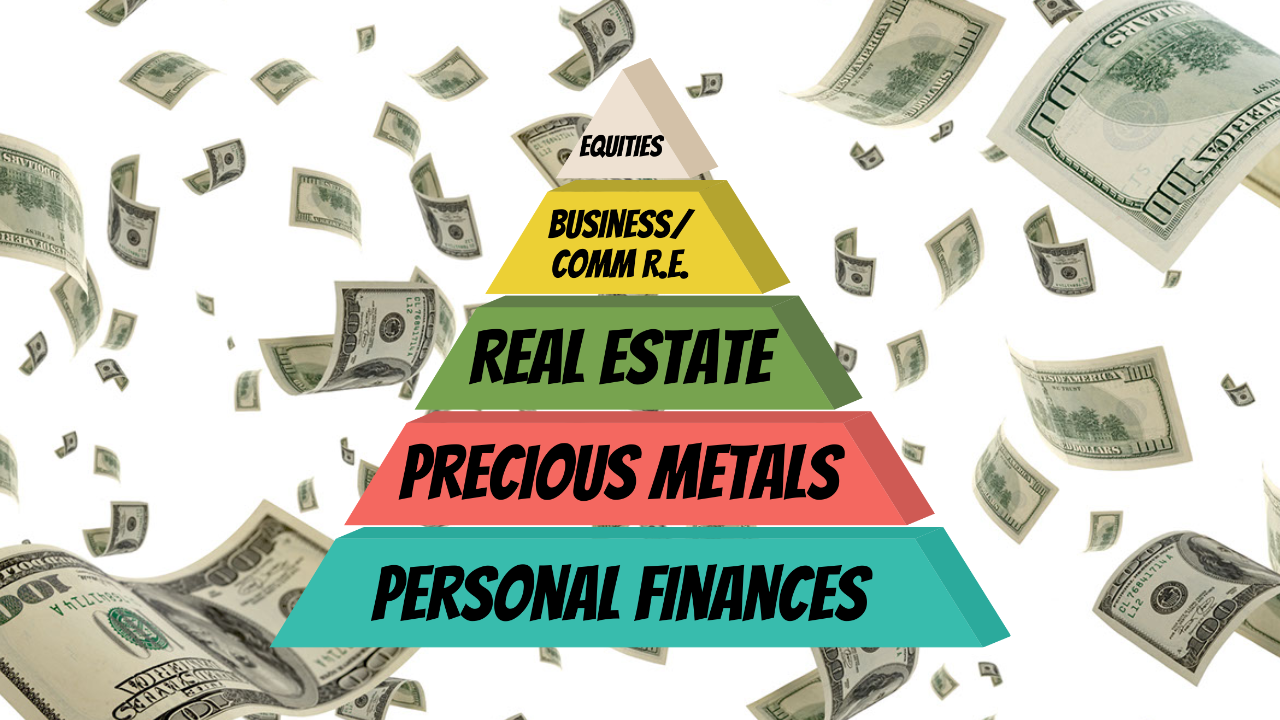Come on, who really doesn’t want to be wealthy? Why do so few of us attain it? I’ll save my theories for another day; instead, let’s start your journey toward wealth today by building your personal wealth pyramid.
In part 1, we discussed Exter’s Pyramid and his assertion that the derivative nature of our financial system will cause the system to collapse on itself. It also provides insights into why so many of us struggle financially. We want to be wealthy, but most of us don’t know how to build toward it.
The “Stackers Real Wealth Pyramid“
As a firm believer in precious metals, we call ourselves “stackers,” and I’ve named this the “Stackers Real Wealth Pyramid.” The first thing we do is learn from our government and commit to building our wealth pyramid on real assets and not financial derivatives, thereby leaving the Upside Down. Leaving the upside down means our pyramid is not inverted, but right side up.
This pyramid is about creating a framework and, in some ways, a roadmap that empowers you to have full control over your life, income, and assets—provided you accept the challenge to be an active participant in your life by taking full responsibility for your financial future.
As you can see from this diagram, our pyramid is right side up because, as we’ve learned from the ancient Egyptians, the pyramid is one of the strongest structures due to its ability to distribute weight evenly, thereby making it resistant to collapsing. The last thing we want is for our personal wealth pyramid to collapse.
My model focuses on five asset classes: personal finances, precious metals, real estate, business and commercial real estate, and equities.
Like Exter’s Pyramid, the more we move away from the pyramid’s base, investors need to be acutely aware that three things change: the risk level, knowledge, and skills needed from you as the investor, as well as the amount of leverage used or available with that asset, as shown in this diagram below.
How to build wealth with the Stackers Real Wealth Pyramid

The key to any structure is its foundation. Building true wealth requires developing a strong base capable of supporting the rest of the structure. In our case, that base is personal finances, as your inability to manage your budget, live within your means, save, and practice general financial discipline will eventually destroy everything you’re creating. Additionally, skills, knowledge, discipline, and related personal finance skills are needed and built upon at each level of the pyramid.
Following our pyramid’s roadmap, the next step is investing in precious metals, specifically monetary metals such as gold, silver, and platinum. This stage in your financial development forces you to learn about “real” money, reinforces being disciplined at saving money (converting fiat currency into metals), establishes a financial “insurance” policy, and provides additional financial liquidity.
I personally view precious metals as liquid assets like cash, simply held in a different form. It’s important to note that your precious metals are in addition to the sound money principle of maintaining three to six months of savings you developed during the first stage. Additionally, these two types of liquidity are essential protections and may even help fund our level three activity, real estate. Why real estate? Nothing creates wealth and leverages financial growth like owning rental real estate. Hopefully, you noticed that I snuck the word “rental” into that phrase. We transition from metals to rental real estate because we want assets that generate income (rental), appreciate, and are something someone else (the renter) pays for/pays us to use.
I don’t know how to help you get rich, but I do know from study and personal experience that this Stackers Wealth Pyramid provides you, the “average” person, a pathway to wealth—wealth that will transform your life and hopefully the next generation. This isn’t quick, and I never said it was easy. If it were easy, everyone would be wealthy. Yet, it’s 100% attainable, and it’s up to you. As famed investor Benjamin Graham once said, “The investor’s chief problem—even his worst enemy—is likely to be himself.”
As a rental real estate owner (real estate investor), the government views you as a business owner, and as a business owner, the tax code provides you with incredible tax savings you can’t utilize as a W-2 wage earner. Paying less in taxes is part of how the wealthy play the game differently. Welcome! With a cash-flowing, appreciating rental property that has a loan being paid down monthly by a tenant, opportunities to level up to businesses or commercial real estate are the natural progression.
While the risks definitely increase, the additional income from real estate and tax savings help to mitigate those risks. The knowledge and skills learned along the way, especially as a real estate investor, serve as an additional hedge. The wealthy learn how to manage risk, not avoid it. You must do the same, which leads us to equities, one of the better ways to create wealth or potentially lose fortunes. Entering this world requires all the skills learned along the way, which, ideally, are funded by excess cash flow or profits.
I don’t know how to help you get rich, but I do know from study and personal experience that this Stackers Wealth Pyramid provides you, the “average” person, a pathway to wealth—wealth that will transform your life and hopefully the next generation.
This isn’t quick, and I never said it was easy. If it were easy, everyone would be wealthy. Yet, it is 100% attainable, and it is up to you. As famed investor Benjamin Graham once said, “The investor’s chief problem—even his worst enemy—is likely to be himself.”






